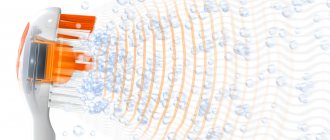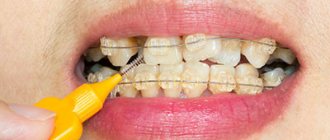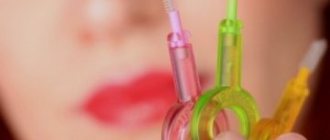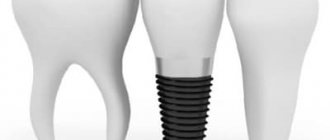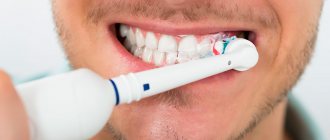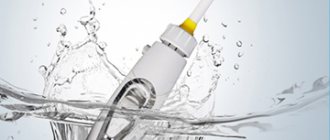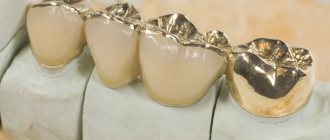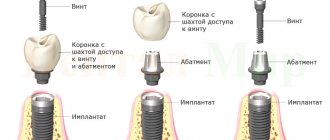Before choosing a nozzle for an oral irrigator, you should familiarize yourself with the different types of removable elements. When purchasing an irrigation device, it is often equipped with a minimum set (2-3 pieces) of universal nozzles. To maintain the oral cavity in proper hygienic condition, doctors recommend that each person acquire several special-purpose attachments. Alternating removable tips helps provide quality daily care and solve many dental problems.
How to properly care for dental implants
You can increase the lifespan of titanium roots by thoroughly cleaning your mouth and visiting the dentist. Equally important is giving up bad habits.
Maintaining oral hygiene is the prevention of complications after implantation.
The time the body gets used to a foreign body is often accompanied by a weakening of the immune system, so you need to follow all the doctor’s recommendations. Requirements for caring for implants can be reduced to two basic rules:
- High-quality cleaning of the oral cavity . Implant installation sites are very vulnerable to a number of dental diseases. Particular care should be taken to clean the area where the denture connects to the gum.
- Preventive examinations by a specialist . Visiting the dentist should be done at least twice a year. Sanitation of the oral cavity allows early detection of tissue inflammation and structural displacement.
The best manufacturers of oral irrigators
Not all companies developing oral irrigators match their technologies with the latest scientific knowledge in the field of dentistry. Because of this, only a limited group of manufacturers can be trusted. The list of the best includes:
- WaterPik is one of the most famous manufacturers of irrigators, which appeared in 1962 in the USA;
- B.Well produced using British technologies; this brand has been available in Russia for almost 13 years;
- Revyline is a domestic manufacturer of high-quality irrigators in various price segments;
- Donfeel is a Russian leader in the production of oral hygiene devices;
- Oral-B company originated in the USA and is still included in the ranking of the most famous international companies.
Irrigator - what is it, what is it for?
To facilitate and increase the efficiency of implant care, a device was created that delivers a thin stream of liquid through a nozzle under strong pressure. The irrigator removes the smallest food debris in the interdental spaces where the brush and floss cannot reach.
Main characteristics
Another useful function is massage. A thin stream of water, in parallel with cleaning, massages the gums, improving blood circulation.
The benefits of an irrigator are significantly increased if, instead of water, you use solutions with an antiseptic, antibacterial effect and fluoride-containing agents. This is an excellent prevention of dental diseases , plus fresh breath and strengthening of enamel.
There are different types of attachments for cleaning implants, and the ability to regulate water pressure. Low pressure is indicated for children and people with gum disease.
Expert opinion : “Cleaning teeth at home can be closer to professional thanks to an irrigator. A useful device that copes with bleeding gums, caries and other dental problems. It allows you to irrigate gum pockets without having to visit a dentist. And when installing prostheses, implants, braces, it is indispensable.”
Indications
It is recommended to use the irrigator:
- pregnant women - during pregnancy, the risk of developing caries and periodontal disease increases;
- patients with malocclusion and crowded teeth, braces;
- for periodontitis - dentists recommend using an irrigator in the initial stages of the disease, using medicinal solutions;
- for patients with orthodontic structures (removable, fixed dentures, implants) - models with appropriate attachments are used;
- smokers - the use of an irrigator helps reduce the risk of developing dental diseases;
- for chronic rhinitis or gingivitis - there are models with a nozzle for rinsing the nose.
Contraindications for use
There are situations when using an irrigator is not recommended:
- with acute periodontitis;
- against the background of treatment of dental diseases;
- after recent dental surgery;
- during the first 2 - 3 weeks after installation of the prosthesis or braces;
- for cardiovascular diseases;
- in case of continued bleeding of the gums after 2 weeks from the start of using the irrigator.
»
Nozzles
Each irrigator is equipped with several nozzles. Their number and type largely determine the functionality of the device.
There are several basic attachments that are included with most irrigators - standard, orthodontic, massage, periodontal and plaque removal attachment.
Standard
The standard nozzle is used for general cleaning. It is distinguished by a short curved neck and a small diameter nozzle that washes one or two teeth. The nozzle is quite effective for general, not very thorough cleaning of braces.
Orthodontic
Compared to the standard one, the orthodontic attachment is equipped with an elongated, narrowed nozzle. A thin jet supplied under high pressure can clean any lock well, even if it is on the second molar.
Massage
This attachment, which has a brush at the end, is intended not only for cleaning braces, but also for massaging the gums.
Its special advantage is that it can dull the pain that the patient experiences after installation or activation of the system.
In addition, massage helps improve blood microcirculation and accelerates tissue regeneration that occurs when teeth move.
To remove plaque
The plaque remover attachment is equipped with three-tuft bristles. It needs to treat the tooth in the same way as a regular brush, while simultaneously applying water.
This attachment will not be able to cope with tartar , but it is quite capable of removing soft plaque and plaque.
Periodontal
The periodontal nozzle is not intended for cleaning braces; it is used to wash periodontal pockets. It is advisable to have it for people with unsatisfactory periodontal condition.
Types of irrigators for implant care
By way of operation
Portable
It runs on batteries or a rechargeable battery, is small in size, lightweight and easy to transport. The average charge is 7 - 10 days. The main advantage is the relatively low price. Disadvantages include the inability to tilt the irrigator body and the lack of liquid access to the nozzle in a horizontal position. The reservoir has a small volume, which is why the liquid is poured only for one treatment. A minimum of attachments and modes are provided. Weak power does not allow creating a jet pressure of sufficient force.
Stationary
Powered by mains power. Compared to a portable irrigator, it is more bulky and therefore takes up more space, but this disadvantage is offset by its long service life. Such irrigators are suitable for family use, since they have a set of several nozzles and different modes. A strong motor provides a powerful jet of liquid. From a sufficiently capacious reservoir, water is directed into the handle through a hose and discharged through the nozzle. The main disadvantages of a stationary irrigator include:
- noisiness;
- risk of electric shock;
- the need to regularly wash, dry, store nozzles in a special container to avoid the accumulation of microbes on them.
Connectable to water supply
An inexpensive, small-sized irrigator that connects to a water tap, for which adapters are provided. It is impossible to connect to the water supply in the absence of additional filtration, which is a disadvantage. Some manufacturers have solved the problem by equipping devices with capsules with antibacterial liquid.
By jet supply
Different models of irrigators create a stream:
- Pulsating - short pulsations (1200 or more micropulses per minute), increasing the effect and speed of removal of soft plaque and bacteria.
- Containing air microbubbles - the water flow mixes with air. When microbubbles explode, they create micro hydraulic shocks, which enhances the process of removing food debris. Saturation of water with oxygen contributes to a more effective fight against microorganisms, especially in the presence of periodontal pockets.
- Regular - a continuous thin stream of water. A technology with a low degree of efficiency, which is inferior to the other two.
Suggested Modes
An important and interesting feature of irrigators is the ability to use different cleaning modes. By changing the parameters of the jet - pressure, flow pattern, mixing with air - you can achieve high purification.
Most irrigators have the following modes:
- Standard. The jet is supplied continuously at one flow rate. This mode can be used to clean exposed surfaces well, but it is not effective enough to clean the complex contours of the lock.
- Throbbing. A thin stream is supplied intermittently, pulsating, delivering separate frequent micro-impacts. This allows you to target the elements of the braces and clean them effectively.
- Microbubble. Water is mixed with air, the bubbles of which collapse when they hit the surface, creating high cleaning energy. This mode allows you not only to clean braces efficiently, but also to remove plaque and create a bactericidal effect.
In addition, as already noted, it is possible to change the pressure and speed of water supply, adapting it for gums with increased sensitivity.
Fluid selection
You can use plain water, but the best effect occurs when using pharmaceutical solutions. They are hygienic (for daily cleaning) and special (prescribed by the dentist after examining the oral cavity). The latter include balms with an anti-inflammatory, hemostatic effect, products based on calcium, fluoride, and potassium to strengthen teeth.
After using the irrigator with medicinal liquid, there is no need to rinse your mouth.
You can combat the increased appearance of stones using a bleaching mixture. You can see the effect after just a few procedures. Do not direct the solution onto the gums, since small abrasive particles and strong pressure during rinsing can damage the mucous membrane. Care must be taken to ensure that the stream does not enter the larynx.
Instructions for use
Before use, the irrigator must be prepared - filled with water if it is stationary or portable, or connected to a water supply if it is a running one. The required nozzle must be installed in the device and the required mode must be turned on.
The first use should be a test. You need to fill the container full with warm water and release it through a standard nozzle in basic mode.
The first practical application should be performed with minimal pressure, especially if the gums are inflamed. The pressure during the cleaning process should be increased gradually.
Cleaning is done by bending over the sink in the following order:
- Open your mouth slightly so that water can flow out of it, and direct the stream to the clasps of the braces, starting with the outermost painters.
- First, clean the lock, paying attention to the places where it contacts the tooth. Then the jet is transferred to the gum line and interdental space. Finally, all other areas are washed.
- It is recommended to complete the cleaning by massaging with a jet or a periodontal massage brush.
- After use, it is recommended to dry the nozzle and put it in its proper place.
How to clean properly
The irrigator does not replace brushing with toothpaste. You need to use it at least three times a week, preferably every day before bed. The frequency of use depends on the condition of the gums.
Immediately after purchasing the device, you need to start cleaning at low speeds , with each procedure slightly increasing the liquid pressure. It should take a couple of weeks to get used to the procedure, otherwise there is a risk of soreness and bleeding of the gums.
The technology for using an irrigator depends on the type of nozzle, but there is an algorithm for standard actions:
- Fill the reservoir with filtered water or an antiseptic solution.
- Fix the nozzle with your lips so that the liquid flows out easily from the oral cavity.
- Tilt over the sink and turn on the appliance.
- Direct the jet from the gums to the edge of the crown, avoiding unnecessary pressure on the pocket.
- To prevent the oral cavity, treat the entire surface of the oral mucosa with the solution.
- When cleaning the teeth on the upper jaw, lean forward to prevent the solution from flowing into the throat.
Expert opinion : “The irrigator can save patients from frequent visits to dentists. Therefore, if they ask me whether it is obligatory in everyday life, I answer unequivocally yes. The device will effectively clean the oral cavity and prevent gum inflammation and caries.”
Each family member should have their own nozzle , subject to periodic replacement. When using herbal infusions, the nozzles and tank are thoroughly washed. On average, brushing your teeth takes 5 to 20 minutes.
How often is it recommended to change different attachments?
The manufacturer recommends changing the irrigator attachments once every three months .
This is due to wear and deformation of some parts of the product , which reduces the quality of cleaning the mouth and teeth, and also increases the risk of injury to the mucous membranes and gums.
Remember! In addition, pathogenic microbes multiply on the bristles during long-term use, which can lead to dental caries and gum inflammation.
Standard tongue cleaners and attachments must be replaced after 6 months of use, as they are made only of plastic and do not have bristles, soft silicone or rubber in their design.
Review of the best models
WaterPik WP-100 Ultra E2
Has adjustable power, 10 operating modes. Creates 1200 pulsations per minute. Powered by mains power. Tank volume - 600 ml. Reliable, durable, easy to use. Has spare parts. The cord is long enough to connect to any outlet. Cleans well, massages gums, has 7 attachments:
- standard;
- for cleaning the tongue;
- brush;
- periodontal;
- orthodontic;
- for implants and crowns.
Among the shortcomings, the lack of a spray mode makes itself felt. The device does not charge contactlessly and does not turn off automatically. The water supply button on the handle periodically gets stuck. Made from low quality plastic.
«
WaterPik WP-450 Cordless Plus
Portable functional device, suitable for travel and home. The battery charge lasts a long time. It has high power (up to 1450 pulsations per minute), and a function for adjusting water pressure. A 210 ml reservoir lasts for 45 seconds. You can use water or medicinal solutions. There are two operating modes and 4 nozzles.
Cons: insufficient number of attachments, does not turn off automatically. There is a tendency for the charge to weaken and the contacts to oxidize. A small reservoir slows down the cleaning process as it must be refilled several times.
Donfeel OR-820D compact
The small size allows you to take it on the go. Space saving is also ensured by the existing compartment for replaceable attachments. The pressure can be adjusted. A thin stream, enriched with oxygen in the form of microscopic bubbles, easily penetrates into the interdental spaces. The set includes 4 nozzles.
Among the shortcomings, it is worth noting the lack of automatic shutdown, bracket and contactless charging. There is also no all-round rotation of the attachments. Inconvenience may arise due to the short length of the power cord and hose.
WaterPik WP-300 Traveler
The stationary irrigator is small in size and takes up little space. Equipped with a universal adapter, which allows you to connect it to different types of sockets. Compared to other models from this manufacturer, the WaterPik WP-300 Traveler is silent. Has four nozzles. Creates 1200 pulsations per minute. Tank volume 450 ml.
Cons: insufficient number of attachments, does not turn off automatically, attachments do not rotate 360 degrees.
VES VIP-004
Portable, compared to other travel models, it is equipped with a spacious tank (600 ml). The set of 7 360 degree rotating attachments includes 3 standard and 4 special ones. Powered by mains or batteries.
Among the disadvantages, it is worth noting the unreliable system for temporarily blocking the flow of water; low pressure cannot be obtained, and with high pressure, the liquid is quickly consumed.
Which irrigator model is better to choose?
Everyone chooses the right model for themselves, taking into account their lifestyle:
- WaterPik WP-450 Cordless Plus and WaterPik WP-100 Ultra E2 - will provide high-quality hygiene at home.
- VES VIP-004 - easy to use.
- WaterPik WP-300 Traveler is a universal option for travel and home.
- Donfeel OR-820D compact - ideal for travel.
Varieties
Depending on functionality, there are three types of irrigators:
- flow-through;
- stationary;
- portable.
Flow-through
This type of device does not have its own capacity. Water enters it from the water supply network through a connected hose. Since it is supplied under main pressure, the device does not require a pump or an energy source driving it.
The only complex component of a flow irrigator is a filter for purifying tap water.
Advantages of flow irrigators:
- simplicity and compactness due to the lack of a container, pump and power source;
- no need to prepare and pour liquid;
- unlimited water consumption;
- filtering water from excess chlorine;
- no need for batteries or accumulators.
Flaws:
- the need to regularly change the filter;
- limited filtration (water is not purified from all harmful components);
- one single water supply mode;
- inability to prepare water of a certain composition.
Stationary
Stationary irrigators are the most common and functional types of devices. They consist of a separately located container with a volume of 0.5-1 liters and a compact device with a button and a nozzle.
Operate from battery or mains. As a rule, they have a large range of different modes and attachments.
Advantages of stationary irrigators:
- sufficient power and high jet pressure;
- no need to save much water.
- the ability to work on battery power for many hours without recharging, or almost unlimitedly from the mains.
- the ability to prepare water of any composition - well filtered, with the necessary medicinal and deodorizing additives.
Flaws:
- it is impossible (or, in any case, inconvenient) to take with you on trips due to the large size of the container;
- the use of unfiltered water shortens the service life;
- Periodic refilling of the container with water is required.
Portable
These are small-sized models, intended mainly for travel use and, therefore, very limited in their functionality.
The container built into the device has a volume of only 200-300 ml. The pump is powered by batteries, which need to be changed from time to time.
Advantages of portable models:
- ease of use while traveling (that’s why it was created);
- the ability to prepare water of the desired composition;
- low price.
Flaws:
- small supply of water (only enough for 1 procedure);
- low pressure;
- the need to frequently change batteries;
- limited functionality (the number of modes usually does not exceed 5);
How Prodigy braces work and how popular they are among patients.
In this publication we will look at the design of Mini Twin braces.
Here https://www.vash-dentist.ru/ortodontiya/breketyi/vestibulyarnyie/kombinirovannyie-vozmozhnost-sekonomit.html you can see photos of all types of combined braces.
What to pay attention to when making your final choice
An irrigator should be purchased after determining how often it will be used and under what conditions. You need to pay attention to:
- Type of jet.
- The ability to adjust the pressure is an important feature, since at first the irrigator should be used with little pressure.
- Set of nozzles included.
- Service - it is advisable that the service center is located in your place of residence.
- Warranty - if a breakdown occurs during the warranty period, the device will be replaced with a new one. However, after the warranty expires, the irrigator will not be subject to repair or return.
Expert opinion : “On rare occasions, patients with healthy teeth come to me. There is generally a negative picture of oral care. Few people know that an irrigator is a universal device, the use of which allows you to visit the dentist less often with bad teeth. It has an affordable price and is quite effective in preventing and combating dental diseases.”
Reviews
Irrigators are one of those devices whose convenience can only be appreciated by using them. The impression made largely depends on the specific model.
If you use an irrigator, tell us what type it is and what impression it leaves on you. The comment form is at the bottom of this page.
If you find an error, please select a piece of text and press Ctrl+Enter.
Tags vestibular braces care
Did you like the article? stay tuned
Previous article
What makes ODP braces different from other systems?
Next article
Taking an impression using the open and closed tray method is the first step to implantation success
Price
The cost of the irrigator will depend on the type of model. The most affordable are portable devices, the price of which varies from 480 to 3500 rubles .
Devices costing up to 1000 rubles, as a rule, do not have special attachments and are equipped with a small reservoir. More expensive models have expanded functionality and a set of additional attachments.
Stationary devices can be purchased at a price of 2,900 rubles . It can increase depending on the number of modes, nozzles and levels of fluid supply adjustment.
The average cost of budget irrigators from well-known manufacturers, with various modes, is 4,500 rubles. Particularly popular are Donfeel OR-820M, Oral-B ProfessionalCare OxyJet MD20, Waterpik WP-70.
When choosing a device, you need to focus not only on the cost, but also on the possibility of servicing the device. In its absence, a breakdown of the irrigator will lead to the need for a new forced purchase.

